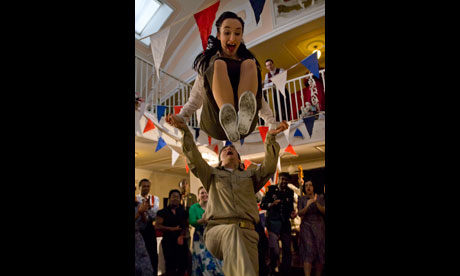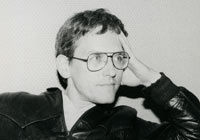

Terry Monaghan, below, and the Jiving Lindy Hoppers. He insisted on the troupe’s multicultural nature.
Terry Monaghan, who has died aged 67 from a brain tumour, was the co-founder of the award-winning dance company the Jiving Lindy Hoppers. He was widely regarded as the world's foremost authority on the history of jazz dance, in particular the lindy hop and its New York home, the Savoy Ballroom in Harlem.

Terry was born in London during the second world war, the son of Frank, who had been a sheet-metal worker before enlisting, and Peggy, a nurse. After the war, both retrained as teachers. Terry's lifelong interest in social dancing began at the regular Sunday evening open house held by his parents, with everyone present expected to "sing, dance or show their navel". He learned to jive with his cousin Toni, and bunked off school to see Buddy Holly. Although classically trained in the piano, he loved playing boogie-woogie, and set up a band with his schoolmates at Marylebone grammar.
Terry did not complete his first degree in philosophy, politics and economics at Regent Street Polytechnic (now the University of Westminster). He was busy recruiting members for the Young Socialists (both his parents were Communist party members), and also worked on building sites and as a postman. While recruiting in west London, he developed a lasting interest in the history of the Caribbean islands and reggae music.
In the mid-1970s Terry trained as a teacher, and in 1979 became an audio-visual technician at the City of London Polytechnic (now London Metropolitan University). He stayed there for more than 15 years, combining this day job with setting up and organising the Jiving Lindy Hoppers. Later, while pursuing doctoral studies at Goldsmiths College, London University, he taught a course on music and the body, from 2007.
In the early 1980s Terry attended a dance workshop run by the dancer and teacher Warren Heyes. Terry showed Warren the lindy hop sequence in the Marx brothers' film A Day at the Races (1937), and they began a collaboration which resulted in the creation of the Jiving Lindy Hoppers, who first performed at the Notting Hill Carnival in 1984. Although Terry originally danced with the company, he focused on the history and development of the dance form, and similar practices now known collectively as "swing dance".
The company developed from amateur to professional status. Terry and Warren recruited and trained several generations of dancers, creating a dedicated and skilled team who have undertaken international tours and television appearances and been engaged in thousands of performances and workshops. The company was offered support by an arts funding body but only if it would agree to be labelled "black dance". The offer was rejected, as the multicultural nature of the company was seen by Terry as integral to the authentic jazz dance tradition itself.
For a number of years, Terry was a board member of the Society of Dance History Scholars. He received a Carter Berger award from the Institute of Jazz Studies, Rutgers University, New Jersey, where he spent many hours reorganising the Marshall Stearns jazz dance and music archives. From 1986, he acted as a consultant in jazz dance styles for television and film. He organised regular swing dance festivals and worked in schools, establishing after-school clubs such as the Chestnut Grove Lindy Hoppers in south London. In 1991, he directed Jazz Dance, a film on the history of African-American social dances for the Arts Council. I worked on this film as a researcher, and we subsequently collaborated on many projects and academic papers together.
Terry had seemingly limitless energy. In 1997 he was artistic director of Flying Home – the Celtic Jazz Connection, with the Jiving Lindy Hoppers and the Irish band Sin é, and featuring swing, Irish and African dance, which eventually transferred to Lincoln Centre, New York. At the South Bank Centre, he staged a number of jazz-tap shows from 2002 onwards. In 2006 Terry co-organised the 80th birthday celebrations of the Savoy Ballroom, held in Harlem at the Alhambra Ballroom.
Between 1985 and 2009, he travelled to the US to carry out oral history interviews with the original practitioners of the Lindy Hop from the 1930s and 1940s, as well as younger dancers and musicians, often developing lasting friendships. He delayed the completion of his doctoral monograph so that he could carry on recording as many of these histories as possible. This research has now accumulated into perhaps the world's largest and most important private archive of this type of material.
Terry was a keen learner of other dance forms, including the Caribbean quadrille and the tango. With his second wife, Eileen, he enjoyed the weekly Irish set-dancing class at Cecil Sharp House, the home of the English Folk Dance Society in Regent's Park, north London. Together they performed at the Dance Around the World festival in 2009.
Terry is survived by Eileen; his mother, Peggy; his children, Jenny, Leah and Harry; and five grandchildren.
• Terry Monaghan, dance historian and activist, born 13 August 1943; died 26 June 2011

Terry was born in London during the second world war, the son of Frank, who had been a sheet-metal worker before enlisting, and Peggy, a nurse. After the war, both retrained as teachers. Terry's lifelong interest in social dancing began at the regular Sunday evening open house held by his parents, with everyone present expected to "sing, dance or show their navel". He learned to jive with his cousin Toni, and bunked off school to see Buddy Holly. Although classically trained in the piano, he loved playing boogie-woogie, and set up a band with his schoolmates at Marylebone grammar.
Terry did not complete his first degree in philosophy, politics and economics at Regent Street Polytechnic (now the University of Westminster). He was busy recruiting members for the Young Socialists (both his parents were Communist party members), and also worked on building sites and as a postman. While recruiting in west London, he developed a lasting interest in the history of the Caribbean islands and reggae music.
In the mid-1970s Terry trained as a teacher, and in 1979 became an audio-visual technician at the City of London Polytechnic (now London Metropolitan University). He stayed there for more than 15 years, combining this day job with setting up and organising the Jiving Lindy Hoppers. Later, while pursuing doctoral studies at Goldsmiths College, London University, he taught a course on music and the body, from 2007.
In the early 1980s Terry attended a dance workshop run by the dancer and teacher Warren Heyes. Terry showed Warren the lindy hop sequence in the Marx brothers' film A Day at the Races (1937), and they began a collaboration which resulted in the creation of the Jiving Lindy Hoppers, who first performed at the Notting Hill Carnival in 1984. Although Terry originally danced with the company, he focused on the history and development of the dance form, and similar practices now known collectively as "swing dance".
The company developed from amateur to professional status. Terry and Warren recruited and trained several generations of dancers, creating a dedicated and skilled team who have undertaken international tours and television appearances and been engaged in thousands of performances and workshops. The company was offered support by an arts funding body but only if it would agree to be labelled "black dance". The offer was rejected, as the multicultural nature of the company was seen by Terry as integral to the authentic jazz dance tradition itself.
For a number of years, Terry was a board member of the Society of Dance History Scholars. He received a Carter Berger award from the Institute of Jazz Studies, Rutgers University, New Jersey, where he spent many hours reorganising the Marshall Stearns jazz dance and music archives. From 1986, he acted as a consultant in jazz dance styles for television and film. He organised regular swing dance festivals and worked in schools, establishing after-school clubs such as the Chestnut Grove Lindy Hoppers in south London. In 1991, he directed Jazz Dance, a film on the history of African-American social dances for the Arts Council. I worked on this film as a researcher, and we subsequently collaborated on many projects and academic papers together.
Terry had seemingly limitless energy. In 1997 he was artistic director of Flying Home – the Celtic Jazz Connection, with the Jiving Lindy Hoppers and the Irish band Sin é, and featuring swing, Irish and African dance, which eventually transferred to Lincoln Centre, New York. At the South Bank Centre, he staged a number of jazz-tap shows from 2002 onwards. In 2006 Terry co-organised the 80th birthday celebrations of the Savoy Ballroom, held in Harlem at the Alhambra Ballroom.
Between 1985 and 2009, he travelled to the US to carry out oral history interviews with the original practitioners of the Lindy Hop from the 1930s and 1940s, as well as younger dancers and musicians, often developing lasting friendships. He delayed the completion of his doctoral monograph so that he could carry on recording as many of these histories as possible. This research has now accumulated into perhaps the world's largest and most important private archive of this type of material.
Terry was a keen learner of other dance forms, including the Caribbean quadrille and the tango. With his second wife, Eileen, he enjoyed the weekly Irish set-dancing class at Cecil Sharp House, the home of the English Folk Dance Society in Regent's Park, north London. Together they performed at the Dance Around the World festival in 2009.
Terry is survived by Eileen; his mother, Peggy; his children, Jenny, Leah and Harry; and five grandchildren.
• Terry Monaghan, dance historian and activist, born 13 August 1943; died 26 June 2011
No comments:
Post a Comment